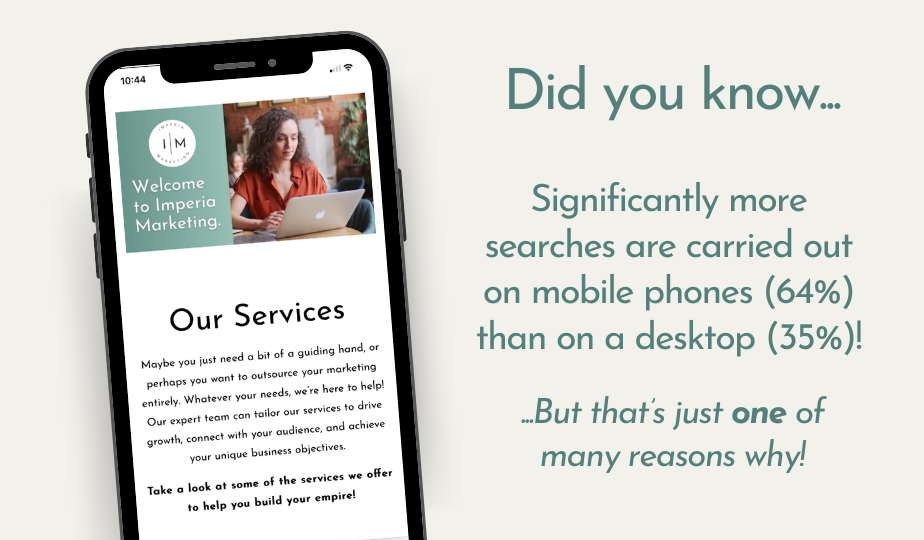Unlocking Success: The Crucial Role of Mobile Optimisation in the Digital Era
Smartphones, an Integral Part of Our Daily Lives! 📱
In a world driven by digital connectivity, smartphones have seamlessly transformed from mere communication devices into the epicentre of our daily activities. Whether we're searching for information, connecting with friends, or making online purchases, our reliance on these pocket-sized powerhouses has become undeniable.
The Mobile Revolution
Consider the last time you sought out information about a company, a place, or a product. Chances are, your journey began on the familiar screen of your mobile device. The convenience and accessibility offered by smartphones have made them the go-to tool for navigating the vast landscape of the internet.
Importance of Mobile Optimization
Recognising this shift in user behaviour, the importance of mobile optimisation for websites cannot be overstated. As users predominantly explore websites in portrait mode on compact screens, it becomes paramount for businesses to ensure that their online presence is not only accessible but also seamlessly enjoyable on mobile devices. The consequence of neglecting mobile optimisation is clear—users may leave in search of information that they can access more conveniently and, most importantly, more quickly.
Effortless Legibility
Mobile optimisation is a multifaceted strategy that involves tailoring your website to provide an effortless reading experience. Text should be legible without the need for zooming, and navigation should be intuitive, allowing users to access information with ease. A user-friendly interface on mobile devices is key to retaining visitors and keeping them engaged.
Visually Appealing Design
The visual appeal of your website on a mobile screen is crucial in making a lasting impression. Optimised websites feature responsive design elements that adapt gracefully to various screen sizes. Images, videos, and other multimedia components should load efficiently, maintaining their quality while enhancing the overall visual experience. A visually engaging website not only captures attention but also communicates professionalism and credibility.
Need for Speed
In the fast-paced digital landscape, users expect instant gratification. A slow-loading website can lead to frustration and increased bounce rates. Mobile optimisation involves optimising images, leveraging browser caching, and employing other techniques to enhance website speed, ensuring a seamless user experience (see our checklist at the bottom of this blog post). A fast-loading site not only improves user satisfaction but also positively impacts search engine rankings.
Now…over to you!
Remember, a user-friendly mobile experience not only satisfies your audience but can also boost your website's visibility in search engines. Keep these simple tips in mind to ensure your website shines on the small screen! 📱✨
Responsive Design: Ensure your website layout adapts seamlessly to various screen sizes, providing a consistent and user-friendly experience across devices.
Effortless Navigation: Streamline your site's navigation for mobile users. Use clear, concise menus and buttons, allowing visitors to find what they need with minimal effort.
Legible Text: Optimise font sizes to ensure easy readability on smaller screens. Avoid tiny fonts that may require zooming, providing a comfortable reading experience for all users.
Optimised Images and Media: Compress and resize images to reduce loading times without compromising quality. Utilize efficient file formats and consider ‘lazy loading’ for media-heavy pages.
Fast Loading Speed: Improve website speed by optimizing code, leveraging browser caching, and minimizing HTTP requests.
Mobile-Friendly Forms: Simplify forms for mobile users by minimising input fields and utilising user-friendly input methods. Ensure easy navigation between form fields.
Cross-Browser Compatibility: Test your website on various mobile browsers to ensure consistent performance. Address any compatibility issues to guarantee a seamless experience for all users.
Clear Call-to-Action (CTA): Place important CTAs prominently on your mobile site. Make it easy for visitors to take desired actions, such as making a purchase or contacting your business.
Optimized Meta Tags: Craft concise and compelling meta titles and descriptions that display effectively on mobile search results, attracting users to click through to your site.
Mobile-Friendly Testing Tools: Utilize online tools like Google's Mobile-Friendly Test to assess and address any issues that may affect your website's mobile performance.

